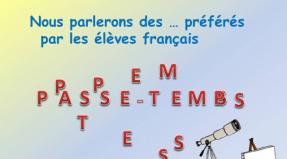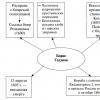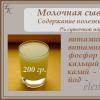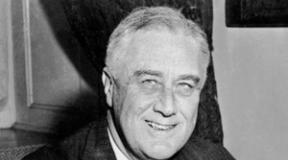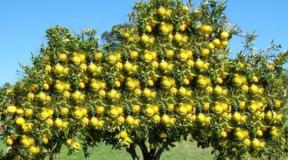Russian literature - symbolism. General characteristics of symbolism Characteristics of symbolism
Symbolism is one of the most complex and controversial trends in Russian literature at the turn of the 19th and 20th centuries. The origins of symbolism were quite diverse, various writers came to it in deeply individual ways, giving this movement extreme diversity, when even its recognized “leaders” sometimes decisively disagreed with each other in defining the “method of pure symbolism.”
On the one hand, the symbolists relied on the idealistic ideas of Plato and liked to express them in Goethe’s words: “Everything that is transitory is only a symbol.” For them everything became mystical, excitingly unclear. Each object bears “a reflection, an oblique refracted ray of the divine.” Each event of earthly life only designates, symbolizes something happening in another, ideal, otherworldly world. Life itself, according to the apt definition of the modern researcher L.K. Dolgopolov, was presented to the symbolists “in the form of a kind of external cover, concealing in its depths something more important, formidable and chaotic, but invisible to the “simple eye”” Dolgopolov L.K. History of Russian poetry in 2 volumes. T. 2. - L.: Nauka, 1969. - p. 257.
All this, it seemed, was supposed to take them far away - and some of them actually did take them away - from the “low-lying” reality with its topical anxieties, needs and concerns. But, on the other hand, for all their repulsion from the surrounding life, the Symbolists were in fact the product of a certain era, its “children.” An era of gigantic social upheavals, wars and revolutions stood at the door, and the Symbolists already felt certain “underground tremors,” although they interpreted them in a religious-mystical spirit. In a surprising way, symbolism and realism will be combined in the work of A. Blok.
Russian symbolism adopted a number of aesthetic and philosophical attitudes from the West, but revised them through the teachings of Vl. Solovyov “about the soul of the world.” Russian symbolist poets experienced with painful intensity the problem of personality and history, their “mysterious connection” with eternity, with the essence of the universal “world process”. For them, the inner world of a person is an indicator of the general tragic state of the “terrible world” of Russian reality, doomed to death. Symbolism included two generations of poets. The first included D. S. Merezhkovsky, V. Ya. Bryusov. K. D. Balmont. In the second - A. A. Blok, A. Bely, V. I. Ivanov.
As a dominant feature of Russian symbolism, one can single out its “panaestheticism”, which is quite clearly manifested in both the implicit (artistic creativity) and explicit (critical-theoretical program) aesthetics of the movement, and in its themes, and in its relation to tradition and modern reality and culture.
The term “panaestheticism” (as a dominant sign of the “picture of the world” and the poetics of symbolism) is in no way synonymous with “aestheticism” and the apology of Beauty. We are talking about the perception and artistic recreation of the world as, fundamentally, an “aesthetic phenomenon” and in the light of certain aesthetic ideas, for example in artistic or critical-theoretical oppositions: beauty - ugliness; harmony - disharmony; space --chaos; art (“dream”) - “prose of life”; creativity - the extra-creative world of “philistinism”, etc.
Symbolist “panaestheticism” in Russian literature manifested itself in three main variants:
- · the “panaesthetic” principle is sharply opposed to any extra-aesthetic reality and is its “antipode”, a “rebellion” against it. Its only embodiment is the inner world of the “I”;
- · the world of the “panaesthetic” is thought of utopically - as a force that transforms extra-aesthetic reality (in the latter, as a rule, in this case its potential involvement in the high principles of being is emphasized). Beauty forms a new world, where Goodness will also enter; objective truth is unconditionally accepted as the “truth about Beauty” - the basis of the universe;
- · “panaesthetic” in the forms of beauty and harmony appears as the highest value, but its opposition to “reality” is noticeably weakened, since “beautiful” is either fenced off from extra-aesthetic reality, avoids it, living according to its own laws, or is found in “sweet life” itself features of the aesthetic; questions of the relationship between Beauty and Good and with “ontological” truth, as a rule, are not raised.
It is easy to notice that the first of these subsystems (“rebellious panaestheticism”) is realized by “decadence”, the second (“utopian panaestheticism”) by the creativity of the “younger symbolists”, the third (“intrinsic aestheticism”) by that “modernist” periphery of symbolism, which is associated with ideas about “pure” Beauty.
D. S. Merezhkovsky (1866-1941) was one of the first to justify the need to choose between the art of “artistic materialism” and the art of “passionate ideal impulses of the spirit”; he made his choice certainly in favor of the latter. He considered the cause of the decline of literature to be the dominance of the realistic method, proclaimed “pure” art, its content being a mystical plot and the messianic role of culture, a grotesque perception of reality. Merezhkovsky believes that true art should include complex symbols, mystical content, and new means of artistic influence. Poetry begins where there is an impulse towards the ideal meaning of eternal images
K. D. Balmont views art in the same spirit. He defines symbolism in poetry as poetry in which two contents organically and non-violently merge: hidden abstraction and obvious beauty. Poetry is where there is an impulse towards a new combination of colors and sounds in their irresistible persuasiveness. Balmont's poetry is characterized by self-affirmation of a strong personality, an enthusiastic reflection of nature, vagueness of thought, and an egoistic code of chosenness.
V. Ya. Bryusov is one of the central figures of Russian symbolism. In his poetry and theoretical works, this movement appears in its most complete, developed and substantiated form. He is convinced that genuine art is elitist. It cannot be accessible and understandable to everyone. Only a sage can truly understand an artist. V. Bryusov placed emphasis on the autonomy of art, on its independence both from science and rational knowledge, and from religion and mysticism; he considers symbolism only as art, seeing in it a special method. The content of his poetry becomes the theme of leaving this world, immersion in the inner world, impulses towards the transcendental, unearthly world, epiphanies and premonitions
Second generation of symbolists , based on the teachings of Vl. Solovyov about “positive All-Unity”, made noticeable changes to the concept of symbolism, which ceases to be a purely aesthetic phenomenon and only art. It acquires a religious and philosophical dimension and draws closer to mysticism and the occult.
The revolution was reflected not only in a sharp change in the theme of symbolism, in the emergence of social, everyday, socio-historical and national themes. Here is how Z. G. Mints writes about the influence of the revolution on symbolism: “What is significant is that in these years not only some layers of the symbolist “picture of the world” are noticeably transformed, but also a new type of “panaesthetic” worldview is created, which radically changes as an explicit , and implicit poetics, including the nature of symbolization, specific forms of “life creativity” arise, etc.” Mints Z. G. Blok and Russian symbolism. // Mints Z.G. Selected works: In 3 books. - Book 3: Poetics of Russian Symbolism. - St. Petersburg: Art, 2004. - P. 182 However, the mechanism of evolution during the transition from the symbolism of the beginning of the century to the symbolism of the era of the revolution is somewhat different than in the cases described above. There is no change in the dominant subsystem of symbolism here: evolution takes the form of a deep restructuring of the “aesthetic utopia.”
The transition from premonitions of “unheard-of changes” and “unprecedented rebellions” to immersion in these “changes” and “rebellions” as in today’s reality poses a choice - it is necessary:
- · or identify what is happening with the embodiment of “harmony in the world”, with the “synthesis” already taking place today,
- · either move away from revolutionary reality without recognizing the emerging Beauty in it,
- · or, finally, somehow change the content of your “panaesthetic” ideal, bringing it closer to what is really happening in Russia.
The first is characteristic, for example, of some of Blok’s attempts in 1904 - early 1905 to comprehend the revolution, in the spirit of his lyrics of 1901-1902, as the descent to earth of a Beautiful Lady (the poem “Her Arrival”); however, these attempts, due to their obvious naivety and inconsistency with what was happening, did not gain much popularity.
Symbolism (from the French word “symbolisme”) is one of the largest movements in the arts (literature, painting, music), it arose in France in the 70-80s of the 19th century, and reached its peak in France, Belgium and Russia at the beginning of the twentieth century. Under the influence of this movement, many types of art radically changed their form and content, changing the very attitude towards them. Followers of the Symbolist movement primarily extolled the primacy of the use of symbols in art; their work was characterized by the release of a mystical fog, a trail of mystery and mystery, the works are full of hints and understatement. The goal of art in the concept of adherents of symbolism is the comprehension of the surrounding world on an intuitive, spiritual level of perception through symbols, which is the only correct reflection of its true essence.
The term “symbolism” first appeared in world literature and art in the manifesto of the same name by the French poet Jean Moreas “Le Symbolisme” (Le Figaro newspaper, 1886), which proclaimed its basic principles and ideas. The principles of the ideas of symbolism are clearly and fully reflected in the works of such famous French poets as Charles Baudelaire, Paul Verlaine, Arthur Rimbaud, Stéphane Mallarmé and Lautréamont.
The poetic art of the early twentieth century, which was in a state of decline and had lost its energy, former strength and bright creativity due to the defeat of the ideas of revolutionary populism, was in urgent need of revival. Symbolism as a literary movement was formed as a protest against the impoverishment of the poetic power of the word, created in order to return strength and energy to poetry, to pour new, fresh words and sound into it.
The beginning of Russian symbolism, which is also considered the beginning of the Silver Age of Russian poetry, is associated with the appearance of an article by the poet, writer and literary critic Dmitry Merezhkovsky “On the causes of decline and new trends in modern Russian literature” (1892). And although symbolism originated in Europe, it was in Russia that it reached its highest peak and Russian symbolist poets brought to it their original sound and something completely new that was absent from its founders.
Russian symbolists were not distinguished by unity of views, they did not have a common concept of artistic understanding of the reality around them, they were disunited and disunited. The only thing they had in common was their reluctance to use simple, ordinary words in their works, their reverence for symbols, the use of metaphors and allegories.
Literary researchers distinguish two stages in the formation of Russian symbolism, which have differences in time and in the ideological concepts of symbolist poets.
The older symbolists who began their literary activity in the 90s of the 19th century include the work of Konstantin Balmont, Valery Bryusov, Dmitry Merezhkovsky, Fyodor Sologub, Zinaida Gippius; for them, the poet was the creator of exclusively artistic and spiritual personal values.
The founder of the St. Petersburg symbolist movement is Dmitry Merezhkovsky, his works written in the spirit of symbolism: the collection “New Poems” (1896), “Collected Poems” (1909). His work differs from other symbolist poets in that he expresses not his personal experiences and feelings, as Andrei Bely or Alexander Blok did, but general moods, feelings of hope, sadness or joy of the whole society.

The most radical and prominent representative of the early symbolists is the St. Petersburg poet Alexander Dobrolyubov, who was distinguished not only by his poetic creativity (a collection of innovative poetry “Natura naturans. Natura naturata” - “generative nature. Generated nature”), but by his decadent way of life, the creation of a folk religious sect of "good lovers".

The creator of his own isolated poetic world, standing apart from the entire modernist movement in literature, is the poet Fyodor Sologub. His work is distinguished by such striking originality and ambiguity that there is still no single correct interpretation and explanation of the symbols and images he created. Sologub’s works are imbued with the spirit of mysticism, mystery and loneliness; they simultaneously shock and attract close attention, not letting go until the last line: the poem “Loneliness”, the prose epic “Night Dew”, the novel “Little Demon”, the poems “Devil’s Swing”, “ One-eyed dashing."

The most impressive and vibrant, full of musical sound and amazing melody, were the poems of the poet Konstantin Balmont, a symbolist of the early school. In search of a correspondence between the semantic sound, color and sound transmission of the image, he created unique semantic and sound texts and music. In them, he used such a phonetic means of enhancing artistic expressiveness as sound writing, used bright adjectives instead of verbs, creating his original poetic masterpieces, which, according to his ill-wishers, were practically meaningless: the poetry collections “This is Me,” “Masterpieces,” “Romances.” without words”, books “The Third Watch”, “To the City and the World”, “Wreath”, “All the Tunes”.

Younger symbolists, whose activity dates back to the beginning of the twentieth century, are Vyacheslav Ivanov, Alexander Blok, Andrei Bely, Sergei Solovyov, Innokenty Annensky, Jurgis Baltrushaitis. This second wave of this literary movement was also called Young Symbolism. A new stage in the development of the history of symbolism coincides with the rise of the revolutionary movement in Russia; decadent pessimism and disbelief in the future are replaced by a premonition of impending inevitable changes.
Young followers of the poet Vladimir Solovyov, who saw the world on the brink of destruction and said that it would be saved by divine beauty, which would unite the heavenly life principle with the earthly, thought about the purpose of poetry in the world around them, the place of the poet in developing historical events, the connection between the intelligentsia and the people . In the works of Alexander Blok (the poem “The Twelve”) and Andrei Bely, one can feel a premonition of impending, violent changes, an imminent catastrophe that will shake the foundations of the existing society and lead to a crisis of humanistic ideas.

It is with symbolism that the creativity, main themes and images of poetic lyrics (World Soul, Beautiful Lady, Eternal Femininity) of the outstanding Russian poet of the Silver Age Alexander Blok are associated. The influence of this literary movement and the poet’s personal experiences (feelings for his wife Lyuba Mendeleeva) make his work mystical and mysterious, isolated and detached from the world. His poems, imbued with the spirit of mystery and riddles, are distinguished by their polysemy, which is achieved through the use of blurry and unclear images, vagueness and uncertainty, the use of bright colors and colors is rejected, only shades and half-hints.
The end of the first decade of the twentieth century was marked by the decline of the Symbolist movement; new names no longer appeared, although individual works were still created by Symbolists. Symbolism as a literary movement had a huge influence on the formation and development of poetic art at the beginning of the twentieth century; with its masterpieces of poetic literature, it not only significantly enriched world art, but also contributed to expanding the scope of consciousness of all humanity.
The current of symbolism was one of the brightest and most noticeable trends of modernism, which had a strong influence on the development of art, poetry, music and literature. The peculiarity was that instead they began to use a certain symbol, which indicated the variability of life and the search for absolute truth.
Peculiarities
Symbolism. What is meant by this term? The peculiarity of this movement was that it was not art, literature or music itself that changed, but the attitude towards these categories. The symbolists were experimenters, they were looking for something new, universal and universal. To do this, they used certain riddles, secrets, hints and understatement.
The main role in direction is played by the human imagination. It is this that creates analogies or certain connections between an object or phenomenon and its image. Symbolism, acmeism, futurism and other trends of this period had a great development on subsequent culture, literature, music and art.

Origin of the term
The direction of symbolism appeared in the 60-70s of the 19th century in France. From there it spread to other countries. Its aesthetic principles were outlined by the poet Jean Moreanos in his article “Symbolism”.
What was proposed by the author? Moreans argued that symbol is the opposite of teaching, rhetoric and lengthy descriptions. The idea must be presented in a special sensory form, which can be achieved with the help of imagination. To do this, the author must use a special style that includes secrets, complex word formations, illusions and reticence.
Signs
Mystery and mystery are not all that symbolism has. direction really? This can be seen through its characteristic features:
- The desire to create an ideal picture of the world.
- Transmission of the most subtle and imperceptible impulses of the soul.
- High imagery, lightness and musicality.
- Use of hints and open endings.
- High rate of use of sound and rhythmic means of literature and poetry.
- Filling of words with various signs.
- Aestheticization of death.
- Targeting elite readers.
An important characteristic was also that the word became a kind of code, a secret that a person could solve with the help of his imagination and soul.

Manifestations of the movement in literature, poetry and art
Symbolism, acmeism and other movements had a strong influence on literature, art and poetry. They filled them with new meaning and allowed us to look at the person himself differently.
As for art, this period is characterized by the use of female images represented in the form of animals, trees or natural phenomena. This allows you to create complex associations and allegories. The truth is hidden from human eyes, but it can be seen using the senses and connecting the role of the subconscious.
Literary symbolism has a very deep and rich history. The works of the authors of this period create numerous illusions and symbols that are brilliantly woven into the prose. Examples of this are the works of John Steinbeck and other authors.
Poetry became the largest and most comprehensive reservoir for symbolism. This is due to the fact that poems have fewer descriptions, so they become an ideal ground for connecting phenomena and their symbols, as well as for the use of illusions, metaphors and secrets.

Differences between symbolism and other movements
At the end of the 19th and beginning of the 20th century, many trends in modernism appeared, which have similar features, but are unique and original movements. It is important to pay attention to the following:
- Acmeism. It emerged from symbolism, but opposed it. The direction foresaw materiality, simplicity of images and high precision of words.
- Futurism. The basis was the rejection of various cultural stereotypes and their destruction. An important place is occupied by technology and processes of urbanization, in which poets saw
- Cubofuturism. Characterized by a rejection of the ideals of the past and an orientation towards the future. Shocking and occasionalisms are used for poetry.
- Egofuturism. This direction is characterized by the use of new foreign words, the cultivation of pure feelings and sensations, and the demonstration of self-love.
- Imagism. The basis for this movement is the creation of a certain image. The main means of expression that was used for this is metaphor, as well as entire metaphorical groups and chains. This direction is characterized by the use of anarchist ideas and stages.
Symbolism, Acmeism, Futurism and other movements of the early 20th century had a strong influence on music, art, poetry, literature and culture in general.

Features of Russian symbolism
The Russian version of the movement initially had the same features and characteristics as the Western one, but over time it showed its own characteristics. Aestheticization of life and panaestheticism are the basis that Russian symbolism possessed. What is this? This is understood as the desire to replace existing logic and morality with various innovative forms.
Russian symbolists are inspired by the historical eras of romanticism, antiquity and the Renaissance. Art begins to be perceived as the guardian of everything beautiful and pure. The connection between culture and the people, the state, and the soil is especially important. This distinguished Russian symbolism from trends in other countries.

Silver Age
This term refers to the figurative period in Russian poetry, which appeared at the beginning of the 20th century. This period is associated with such names as Nikolai Gumilev, Alexander Blok, Vladimir Mayakovsky and other outstanding personalities.
The symbolism of the Silver Age was heterogeneous, and it can be divided into two stages:
- Senior. The poets of this time perceived symbolism as a creation of feelings and artistic values. Aesthetics play an important role here. This group includes Bryusov, Balmont, Merezhkovsky, Sologub and others.
- Younger. Symbolism begins to be perceived as a philosophical and religious phenomenon. This period is represented by the names of Blok, Bely, Ivanov and others.
Symbolism is a vibrant movement of modernism that has had a strong influence on music, poetry, literature and art. A characteristic feature of the movement was the use of images of mystery, understatement, which can be revealed with the help of imagination and feelings. Symbolism had much in common with other movements of the early 20th century, but was distinguished by its originality and uniqueness.
This movement deserves special attention in Russia, where it used Western ideas, but offered its own distinctive features and characteristics. This includes connection with the people and the state and reference to other historical eras.
Representatives of these literary movements
Main directions in poetry (Acmeism, symbolism, futurism).
Poetry of reality: main features, themes,
(from the Greek symbolon - symbol, sign) - a literary and artistic movement of the late 19th - early 20th centuries. The foundations of the aesthetics of symbolism were formed in the late 70s. in the works of French poets - P. Verlaine, Lotriamont, A. Rimbaud, S. Mallarmé and others.
Symbolism arises at the junction of eras as an expression of the general crisis of Western-style civilization. Apocalypse in the perception of the world- one of the characteristic features of symbolism.
Nietzsche's idea about the cyclical development of civilization: decline alternates with prosperity; decline occurs when the spirit loses its “musical element”, loses its sense of strength and power, when culture begins to express itself in civilization.
Symbolism had a great influence on all subsequent development of literature and art.
Main features:
- Continuity with Romanticism, the theoretical roots of symbolism go back to the philosophy of A. Schopenhauer and E. Hartmann, to the work of R. Wagner and some ideas of F. Nietzsche.
- Symbolism was primarily aimed at the artistic commemoration of “things in themselves” and ideas that are beyond sensory perception. Poetic symbol was seen as a more effective artistic tool than the image, helping to break through the veil of everyday life to the supertemporal O and the ideal essence of the world." Thus, the symbolists proclaimed an intuitive comprehension of world unity through the symbolic discovery of correspondences and analogies (for example, shape and color, between sound and smell, etc.)
- The musical element was declared the primordial basis of life and art(an idea that finds its expression in Wagner and Nietzsche). Hence the dominance of the lyrical-poetic principle, the belief in the suprareal or irrational-magical power of poetic speech.
- Symbolists turn to ancient and medieval art in search of genealogical relationships.
Russian symbolism:
He adopted many philosophical and aesthetic attitudes from the West (largely changing them through the teaching of V. Solovyov about the “soul of the world”). The features of Russian symbolism are associated primarily with the features of the historical era in which it developed. Having emerged and developed in the 10s. XX century, Russian symbolism was distinguished by an even more catastrophic worldview (the work of A.A. Blok, V.Ya. Bryusov, V. Ivanov). Symbolism is directly related to such a concept as “decadence” (lit. - decline), this is especially acutely felt in Russian symbolism. Another feature of Russian symbolism is its keen attention to the search for the role of the individual in history, to its connection with “eternity” and the essence of the universal “world process”.
In the field of genres, the Symbolists were adherents of strict forms. The sonnet genre has become widespread. However, many old genres underwent symbolistic “modernization” - for example, the symbolic plays of A. Blok (“Balaganchik”, “Rose and Cross”), which revived the medieval theatrical tradition and the theater of the Renaissance (“comedy of masks”), the novels of A. Bely (“Petersburg ", "Moscow").
Organizational centers of Russian symbolists are the publishing houses “Scorpion”, “Grif” and “Musaget”; magazines “Scales”, “Golden Fleece”, partly “World of Arts”.
Konstantin Dmitrievich Balmont (1867-1942)
Nichevoki | New Peasant Poets | Poets of "Satyricon" | Constructivists | Oberiuts | Poets outside the currents | Personalities
Silver Age. Symbolism
Symbolism (from Greek simbolon - sign, symbol) - a movement in European art of the 1870s - 1910s; one of the modernist movements in Russian poetry at the turn of the 19th – 20th centuries. Focuses primarily on expression through symbol intuitively comprehended entities and ideas, vague, often sophisticated feelings and visions.
The word itself "symbol" in traditional poetics it means “multi-valued allegory,” that is, a poetic image that expresses the essence of a phenomenon; in the poetry of symbolism, he conveys the individual, often momentary ideas of the poet.
The poetics of symbolism is characterized by:
- transmission of the subtlest movements of the soul;
- maximum use of sound and rhythmic means of poetry;
- exquisite imagery, musicality and lightness of style;
- poetics of allusion and allegory;
- symbolic content of everyday words;
- attitude to the word as a cipher of some spiritual secret writing;
- understatement, concealment of meaning;
- the desire to create a picture of an ideal world;
- aestheticization of death as an existential principle;
- elitism, focus on the reader-co-author, creator.


